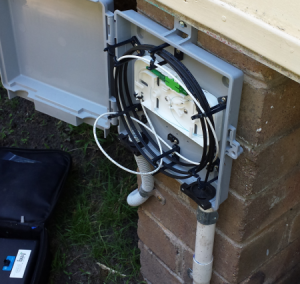 With the CPE boxes installed and the fibre tail dug into your house, the third, and final, NBN contractor appointment brings the two ends together.
With the CPE boxes installed and the fibre tail dug into your house, the third, and final, NBN contractor appointment brings the two ends together.
The fibre tail is connected to the internal cable at the external ONT unit. The technician will then “make a phone call” to test the connection and do a fibre signal quality test.
When the work is done (about 15-30 minutes) the internal ONT will display a green light for the active fibre connection.
With all the physical networking complete, it’s then just a matter of getting the authentication details from your RSP and connecting to your newly provisioned fibre service. I did hear conflicting reports that this can take from one to 48 hours so your mileage may vary. In my case I contacted my RSP and within a couple of ours I had my authentication details.
Actually conneting to an NBN service is much the same as DSL. Simply plug in your wireless router with the Ethernet WAN port to a UNIV-D port on the ONT, put in your auth details and connect with PPPoE. Your IPv4 and DNS settings will be obtained by the router.
On a side note, the default login and password for my new wireless router was “admin/admin” so little wonder I went ahead and changed it.
Preliminary testing
What do you do when you’ve got NBN connected? Notice the speed difference of course!
As part of this whole experiment I opted for an entry level NBN plan of 12Mbps down and 1Mbps up (12Mbps/1Mbps). The DSL service I have is the theoretical maximum of 24Mbps/buggerallMbps and I’m not that far from my exchange (about 1Km as the crow flies).


A simple real world test immediately proved that the SLOWEST NBN plan is FASTER than the FASTEST ADSL plan available on the market. Of course, YMMV, but I believe I am not alone by any stretch of the imagination and thousands of people will experience the same outcome when moving from DSL to FTTP – let alone the high-speed fibre plans. This is the “real world” speed problem that FTTP overcomes. All FTTN will do is waste a lot of money reducing this problem and not solve it.
Next, I’ll do some testing of VoIP over the NBN.
What to do when the NBN comes to town blog series: